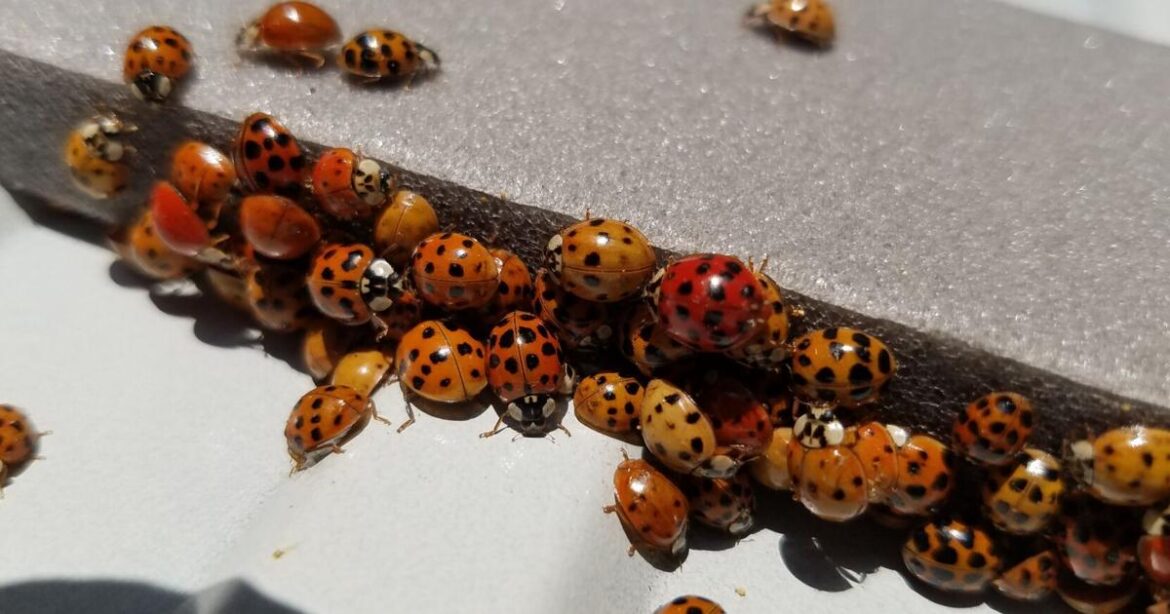Insects are a celebrated part of our natural ecosystems, but when they enter our homes, it’s rarely anything to celebrate. Each fall, as cold weather closes in, there are a few usual suspects that surface at my house to cause a hubbub. However, these exotic house guests are rarely a serious issue but more of an annoyance.
Home-invasive insects that show up en masse are not typically native species. With the exception of our native box elder bug (Boisea trivittata), which does invade indoor spaces, most of these intruders were introduced to the U.S. from another continent. Many times these introductions were accidental, but in some cases, they were intentionally introduced by humankind.
Each year in my home, the two most populous indoor insects that we notice in the wintertime are the Asian lady beetle (Harmonia axyridis) and the brown marmorated stink bug (Halyomorpha halys). Each of these species has a different story of its introduction to our continent, but both of these Asian invaders have rapidly occupied states from coast to coast.
The brown marmorated stink bug was first detected in Pennsylvania in 2001, although it is believed to have been established prior to this but had not been reported previously. This species resembles many of our native stink bugs, characterized by its distinctive shield-shaped appearance. As cool weather sets in, adult brown marmorated stink bugs often seek out human structures for overwintering. This propensity for human-built items has contributed to their rapid spread since their introduction into the U.S.
The insect winds up in many homes each winter but also occupies vehicles, campers, boats and other large, mobile, human-built objects. As a result, many unknowing human chauffeurs have aided in its conquest toward the west coast in recent decades, with 42 states now reporting this pest.
This insect has a wide host range, feeding on everything from vegetables and tree fruits to row crops such as corn and soybeans. The mid-Atlantic region, the epicenter of its introduction, has suffered significant economic losses from this pest in recent years, as it feeds on numerous important human crops. In Illinois, it is becoming a greater problem each year and is only expected to increase.
However, in our homes, this insect is no serious problem but rather more of a nuisance with its looming presence and stinky smell when disturbed. Thankfully, it does not cause humans any harm and doesn’t feed, reproduce or perform any other life processes during the wintertime. The only reason we see it active is because the warmth of our home confuses this insect, delaying its normal inactivity during winter.
The Asian lady beetle has an entirely different story associated with its introduction, but it also has strong ties to the U.S. agricultural system. Surprisingly, this pest to homeowners actually assists with control of other insect pests, such as aphids and scale, which affect both agricultural crops and the home garden. Its introduction is shrouded in mystery, as many attempts to establish this pest predator were made, dating back to the early 20th century. However, it wasn’t until the 1980s that an established population arose in southern Louisiana, and the rest is history. It now occupies nearly every state in the continental U.S.
Like the stink bug, this indoor pest is looking for a warm overwintering location, and while it is quite annoying, it carries little risk to human health. They do have the ability to pinch or bite humans, which can really get your attention but rarely causes true harm. When disturbed, they do exude a smelly substance as a defense mechanism. Although it’s an unforgettable smell, it’s relatively harmless for most. Some have reported allergic reactions to these beetles, likely from the smelly fluid they release, which poses the most serious human threat.
With both of these pests, the best control method is exclusion from the home by sealing up spaces around windows, doorways and soffits. However, that can be a challenging task since they have the uncanny ability to squeeze through the tiniest of cracks. If they do make it inside, I found a hand-held vacuum to be the simplest method of control. It’s relatively easy to vacuum them up and deposit them in outdoor trash.
While these unwanted guests may occupy our homes in the colder months, take solace in the fact that warmer weather will effectively evict them and give you a chance to seal up your home before next year.
Ryan Pankau is horticulture extension educator with University of Illinois Extension serving Champaign, Ford, Iroquois and Vermilion counties.


Comments are closed.